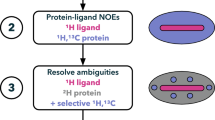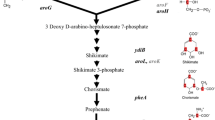Abstract
A common obstacle to NMR studies of proteins is sample preparation. In many cases, proteins targeted for NMR studies are poorly expressed and/or expressed in insoluble forms. Here, we describe a novel approach to overcome these problems. In the protein S tag-intein (PSTI) technology, two tandem 92-residue N-terminal domains of protein S (PrS2) from Myxococcus xanthus is fused at the N-terminal end of a protein to enhance its expression and solubility. Using intein technology, the isotope-labeled PrS2-tag is replaced with non-isotope labeled PrS2-tag, silencing the NMR signals from PrS2-tag in isotope-filtered 1H-detected NMR experiments. This method was applied to the E. coli ribosome binding factor A (RbfA), which aggregates and precipitates in the absence of a solubilization tag unless the C-terminal 25-residue segment is deleted (RbfAΔ25). Using the PrS2-tag, full-length well-behaved RbfA samples could be successfully prepared for NMR studies. PrS2 (non-labeled)-tagged RbfA (isotope-labeled) was produced with the use of the intein approach. The well-resolved TROSY-HSQC spectrum of full-length PrS2-tagged RbfA superimposes with the TROSY-HSQC spectrum of RbfAΔ25, indicating that PrS2-tag does not affect the structure of the protein to which it is fused. Using a smaller PrS-tag, consisting of a single N-terminal domain of protein S, triple resonance experiments were performed, and most of the backbone 1H, 15N and 13C resonance assignments for full-length E. coli RbfA were determined. Analysis of these chemical shift data with the Chemical Shift Index and heteronuclear 1H–15N NOE measurements reveal the dynamic nature of the C-terminal segment of the full-length RbfA protein, which could not be inferred using the truncated RbfAΔ25 construct. CS-Rosetta calculations also demonstrate that the core structure of full-length RbfA is similar to that of the RbfAΔ25 construct.




Similar content being viewed by others
References
Delaglio F, Grzesiek S, Vuister GW, Zhu G, Pfeifer J, Bax A (1995) NMRPipe: a multidimensional spectral processing system based on UNIX pipes. J Biomol NMR 6(3):277–293
di Guan C, Li P, Riggs PD, Inouye H (1988) Vectors that facilitate the expression and purification of foreign peptides in Escherichia coli by fusion to maltose-binding protein. Gene 67(1):21–30
Durst FG, Ou HD, Lohr F, Dotsch V, Straub WE (2008) The better tag remains unseen. J Am Chem Soc 130(45):14932–14933
Elleuche S, Poggeler S (2010) Inteins, valuable genetic elements in molecular biology and biotechnology. Appl Microbiol Biotechnol 87(2):479–489
Esposito D, Chatterjee DK (2006) Enhancement of soluble protein expression through the use of fusion tags. Curr Opin Biotechnol 17(4):353–358
Etchegaray JP, Inouye M (1999) Translational enhancement by an element downstream of the initiation codon in Escherichia coli. J Biol Chem 274(15):10079–10085
Fox JD, Kapust RB, Waugh DS (2001) Single amino acid substitutions on the surface of Escherichia coli maltose-binding protein can have a profound impact on the solubility of fusion proteins. Protein Sci 10(3):622–630
Harlocker SL, Bergstrom L, Inouye M (1995) Tandem binding of six OmpR proteins to the ompF upstream regulatory sequence of Escherichia coli. J Biol Chem 270(45):26849–26856
Huang YJ, Swapna GV, Rajan PK, Ke H, Xia B, Shukla K, Inouye M, Montelione GT (2003) Solution NMR structure of ribosome-binding factor A (RbfA), a cold-shock adaptation protein from Escherichia coli. J Mol Biol 327(2):521–536
Huth JR, Bewley CA, Jackson BM, Hinnebusch AG, Clore GM, Gronenborn AM (1997) Design of an expression system for detecting folded protein domains and mapping macromolecular interactions by NMR. Protein Sci 6(11):2359–2364
Inouye M, Inouye S, Zusman DR (1979) Biosynthesis and self-assembly of protein S, a development-specific protein of Myxococcus xanthus. Proc Natl Acad Sci USA 76(1):209–213
Kainosho M, Torizawa T, Iwashita Y, Terauchi T, Mei Ono A, Guntert P (2006) Optimal isotope labelling for NMR protein structure determinations. Nature 440(7080):52–57
Kishii R, Falzon L, Yoshida T, Kobayashi H, Inouye M (2007) Structural and functional studies of the HAMP domain of EnvZ, an osmosensing transmembrane histidine kinase in Escherichia coli. J Biol Chem 282(36):26401–26408
Kobashigawa Y, Kumeta H, Ogura K, Inagaki F (2009) Attachment of an NMR-invisible solubility enhancement tag using a sortase-mediated protein ligation method. J Biomol NMR 43(3):145–150
Kobayashi H, Yoshida T, Inouye M (2009) Significant enhanced expression and solubility of human proteins in Escherichia coli by fusion with protein S from Myxococcus xanthus. Appl Environ Microbiol 75(16):5356–5362
Lockless SW, Muir TW (2009) Traceless protein splicing utilizing evolved split inteins. Proc Natl Acad Sci USA 106(27):10999–11004
Moseley HNB, Monleon D, Montelione GT (2001) Automatic determination of protein backbone resonance assignments from triple resonance nuclear magnetic resonance data. Nucl Magn Reson Biol Macromol 339(Pt B):91–108
Moseley HN, Sahota G, Montelione GT (2004) Assignment validation software suite for the evaluation and presentation of protein resonance assignment data. J Biomol NMR 28(4):341–355
Muona M, Aranko AS, Raulinaitis V, Iwai H (2010) Segmental isotopic labeling of multi-domain and fusion proteins by protein trans-splicing in vivo and in vitro. Nat Protoc 5(3):574–587
Otomo T, Teruya K, Uegaki K, Yamazaki T, Kyogoku Y (1999) Improved segmental isotope labeling of proteins and application to a larger protein. J Biomol NMR 14(2):105–114
Qing G, Ma LC, Khorchid A, Swapna GV, Mal TK, Takayama MM, Xia B, Phadtare S, Ke H, Acton T et al (2004) Cold-shock induced high-yield protein production in Escherichia coli. Nat Biotechnol 22(7):877–882
Romanelli A, Shekhtman A, Cowburn D, Muir TW (2004) Semisynthesis of a segmental isotopically labeled protein splicing precursor: NMR evidence for an unusual peptide bond at the N-extein-intein junction. Proc Natl Acad Sci USA 101(17):6397–6402
Shen Y, Lange O, Delaglio F, Rossi P, Aramini JM, Liu G, Eletsky A, Wu Y, Singarapu KK, Lemak A et al (2008) Consistent blind protein structure generation from NMR chemical shift data. Proc Natl Acad Sci USA 105(12):4685–4690
Shen Y, Delaglio F, Cornilescu G, Bax A (2009) TALOS+: a hybrid method for predicting protein backbone torsion angles from NMR chemical shifts. J Biomol NMR 44(4):213–223
Smith DB, Johnson KS (1988) Single-step purification of polypeptides expressed in Escherichia coli as fusions with glutathione S-transferase. Gene 67(1):31–40
Southworth MW, Adam E, Panne D, Byer R, Kautz R, Perler FB (1998) Control of protein splicing by intein fragment reassembly. EMBO J 17(4):918–926
Suzuki M, Zhang J, Liu M, Woychik NA, Inouye M (2005) Single protein production in living cells facilitated by an mRNA interferase. Mol Cell 18(2):253–261
Suzuki M, Roy R, Zheng H, Woychik N, Inouye M (2006) Bacterial bioreactors for high yield production of recombinant protein. J Biol Chem 281(49):37559–37565
Swapna GV, Shukla K, Huang YJ, Ke H, Xia B, Inouye M, Montelione GT (2001) Resonance assignments for cold-shock protein ribosome-binding factor A (RbfA) from Escherichia coli. J Biomol NMR 21(4):389–390
Yamazaki T (1998) Segmental Isotope Labeling for Protein NMR Using Peptiide Splicing. J Am Chem Soc 120:2
Zhou P, Wagner G (2010) Overcoming the solubility limit with solubility-enhancement tags: successful applications in biomolecular NMR studies. J Biomol NMR 46(1):23–31
Zhou P, Lugovskoy AA, McCarty JS, Li P, Wagner G (2001a) Solution structure of DFF40 and DFF45 N-terminal domain complex and mutual chaperone activity of DFF40 and DFF45. Proc Natl Acad Sci USA 98(11):6051–6055
Zhou P, Lugovskoy AA, Wagner G (2001b) A solubility-enhancement tag (SET) for NMR studies of poorly behaving proteins. J Biomol NMR 20(1):11–14
Zimmerman DE, Kulikowski CA, Huang Y, Feng W, Tashiro M, Shimotakahara S, Chien C, Powers R, Montelione GT (1997) Automated analysis of protein NMR assignments using methods from artificial intelligence. J Mol Biol 269(4):592–610
Züger S, Iwai H (2005) Intein-based biosynthetic incorporation of unlabeled protein tags into isotopically labeled proteins for NMR studies. Nat Biotechnol 23(6):736–740
Acknowledgements
We thank Tom W. Muir (Rockefeller University) and Yohei Miyanoiri (Nagoya University) for helpful discussions. This work was supported in part by the National Institutes of General Medical Science Protein Structure Initiative (PSI-Biology) program, grant U54 GM 094597 (to G. T. M).
Author information
Authors and Affiliations
Corresponding author
Electronic supplementary material
Below is the link to the electronic supplementary material.
Rights and permissions
About this article
Cite this article
Kobayashi, H., Swapna, G.V.T., Wu, KP. et al. Segmental isotope labeling of proteins for NMR structural study using a protein S tag for higher expression and solubility. J Biomol NMR 52, 303–313 (2012). https://doi.org/10.1007/s10858-012-9610-0
Received:
Accepted:
Published:
Issue Date:
DOI: https://doi.org/10.1007/s10858-012-9610-0




